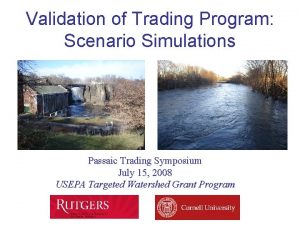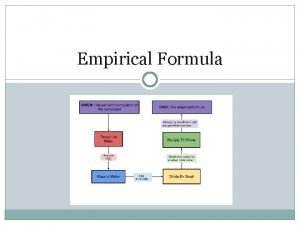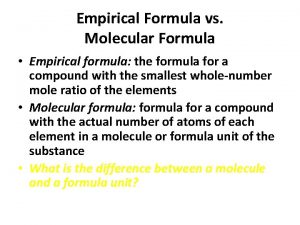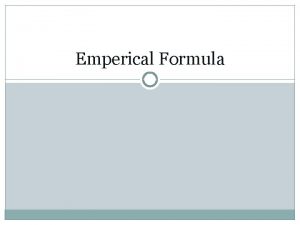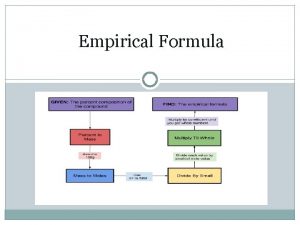Passaic Trading Formula Passaic Trading Symposium July 15












- Slides: 12

Passaic Trading Formula Passaic Trading Symposium July 15, 2008 USEPA Targeted Watershed Grant Program

Formula for trading • NJDEP guidance – The trading program should attain the same or better result as 0. 4 mg/l long term avg. (LTA) TP from each discharger on an annual basis *. • • • System is more sensitive to concentration of discharge than the load Trades must function to offset deviations of LTA from 0. 4 mg/l Best way to do this: base the trading allocation on discharger actual flow, rather than permitted flow – Trading allocation is < TMDL allocation • * Modified for Lower Passaic dischargers (seasonal limits)

Formula for trading (cont. ) • Recommended formula Allocation = (0. 4 mg/l LTA * Anticipated Actual Discharger Flow) • Anticipated Actual Discharger Flow based on average of 2005 -2007 actual flow from facility. Balance = Allocation – Load Discharged - Actual load sold + Equalized load purchased

Formula for trading (cont. ) [(0. 4 mg/l LTA * Anticipated Actual flow) – Load Discharged] - Actual load sold + Equalized load purchased • What if allocation is based on permitted flow? – Seller can take credit for more pounds than it has really removed; risk to stream • Load discharged is function of actual LTA and flow from facility

Formula for trading (cont. ) BALANCE = Allocation – Load Discharged - Actual load sold + Equalized load purchased Ø Actual load sold • Load below allocation that seller has removed from effluent and sold Ø Equalized load purchased = (Actual load sold * Trading ratioseller to buyer) • Uses trading ratio to account for attenuation of TP between buyer and seller; all diversion conditions accounted for • Trading ratio of 0. 5 means that 0. 5 kg discharged from seller has same effect at target location as 1 kg discharged from buyer • Trading ratio table developed to guide all dischargers

Trading ratio table • Grouped by management area and then point source zone – Three management areas • Upper Passaic, Pompton, Lower Passaic – Nine point source zones • • • Dead River Zone Upper Passaic Zone 1 Upper Passaic MA Upper Passaic Zone 2 Whippany Zone Rockaway Zone Pompton Headwaters Zone Pompton MA Two Bridges Zone Lower Passaic Zone 1 Lower Passaic MA Lower Passaic Zone 2

Example of trading ratio table (Based on No Diversion, Extreme Diversion Scenarios) Buyer Seller Upper Passaic Dead River Lower Passaic Zone 2 (UP Zone (UP MA) Zone 1 (LP MA) Upper Passaic Zone 1 (UP MA) 0. 90 0. 78 0. 57 Whippany Zone (UP MA) 0. 82 0. 77 0. 52 Pompton Headwater Zone (Pompton MA) 0. 49 0. 43 0. 29 Lower Passaic Zone 2 (LP MA) 0. 87

Derivation of trading ratios • Omni Environmental performed attenuation analysis using calibrated TMDL model • Considered “no diversion”, “diversion”, and “extreme diversion” scenarios • Calculated attenuation of TP load from each zone as load moves downstream • Result: “Zonal persistence coefficient” or ZPC for each zone • ZPC is percent of discharged load that reaches target location

Example – Persistence coefficient analysis ZPC vs. location (annual load, Upper Passaic Zone 1, no diversion)

Derivation of trading ratios (cont. ) • Trading ratio = (Seller ZPC / Buyer ZPC), relative to common critical location. – Some ratios have 2 common critical locations; choose the critical location which yields the lower ratio. • Calculate trading ratio for each diversion scenario, and select lowest ratio; max protection for WQ – Ratios further reduced by 10% as margin of safety – Experimented with “average” ratios, and “minimum” ratios in trade scenario simulations • Unsatisfactory results

Derivation of trading ratios: Example inter-MA trade, Pompton selling to Upper Passaic • Seller: Two Bridges SA (Two Bridges Zone) – – ZPC at Dundee Lake = 0. 93, no diversion ZPC at Dundee Lake = 0. 47, diversion ZPC at Dundee Lake = 0. 25, extreme diversion ZPC at Wanaque South = 1. 00, extreme diversion • Buyer: Warren Twp SA – Stage 5 (Dead Zone) – – ZPC at Dundee Lake = 0. 77, no diversion ZPC at Dundee Lake = 0. 62, diversion ZPC at Dundee Lake = 0. 37, extreme diversion ZPC at Wanaque South = 0. 13, extreme diversion • Trading ratio = (Seller ZPC/Buyer ZPC) – – No diversion, trading ratio = 1. 21 = (0. 93/0. 77) Diversion, trading ratio = 0. 76 = (0. 47/0. 62) Extreme diversion, trading ratio = 0. 68 = min (0. 25/0. 37 , 1. 0/0. 13) Select 0. 90*0. 68 as trading ratio = 0. 61















